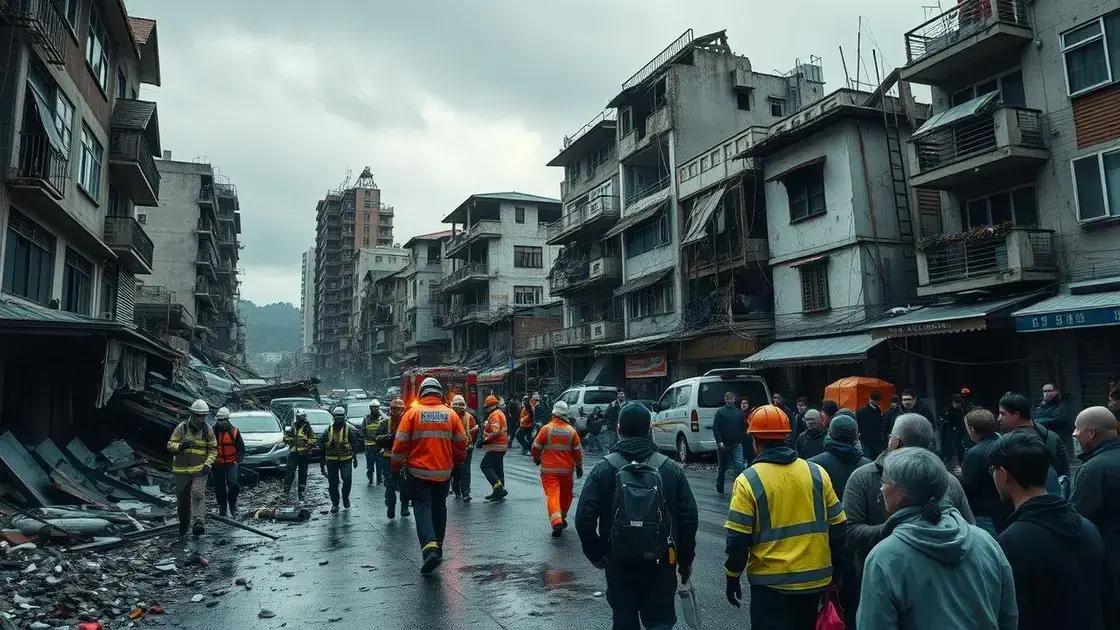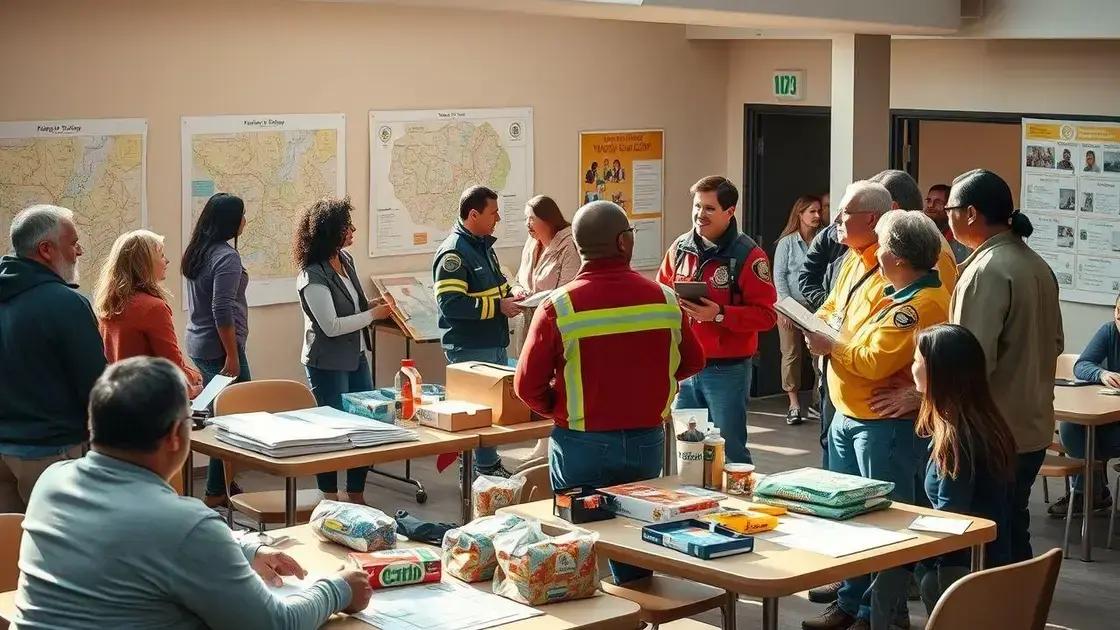Emergency response failures during natural disasters: what went wrong?

Emergency response failures during natural disasters are primarily caused by miscommunication, inadequate resources, and the lack of community involvement, which can be mitigated through improved training, technology, and strategic partnerships.
Emergency response failures during natural disasters can have devastating impacts on communities. Have you ever wondered how these failures happen and what can be done to prevent them? Let’s dive into this critical issue.
Common causes of emergency response failures
Understanding the common causes of emergency response failures is crucial to improving how we handle natural disasters. These failures can result in tragic losses and widespread confusion. By identifying what goes wrong, we can enhance future preparedness.
Miscommunication among agencies
One major issue often arises from poor communication between different response teams. When organizations do not share information effectively, coordination suffers, leading to delays. This can happen for various reasons, such as:
- Lack of clear communication channels
- Insufficient training on inter-agency collaboration
- A failure to establish a unified command structure
Emphasizing reliable communication systems is essential to mitigate misunderstandings during crises.
Inadequate resource allocation
Another significant factor contributing to failures in emergency response is the inadequate allocation of resources. When an emergency occurs, responders often face shortages of essential supplies. This situation can stem from:
- Insufficient funding for preparedness plans
- Poor inventory management systems
- Lack of emergency drills to test resource availability
Addressing these issues can lead to better placement of resources where they are most needed during a disaster.
Moreover, the unpredictability of disasters poses challenges. Many times, plans are developed based on past events that do not accurately reflect current risks. This can leave areas unprepared for new types of fatalities or damage, highlighting the importance of flexible, updated emergency plans that reflect the current climate and environment. On top of that, public awareness plays a vital role; not knowing how to react can lead to chaos and hinder effective response efforts.
In summary, tackling the common causes of emergency response failures requires a multi-faceted approach. By improving communication, proper resource allocation, and keeping emergency plans updated, we can enhance overall effectiveness in future disasters.
Case studies of natural disasters
Learning from case studies of natural disasters helps us understand what went wrong and how we can improve responses in the future. These real-life examples provide valuable insights into emergency management.
Hurricane Katrina
One of the most well-known disasters is Hurricane Katrina, which struck in 2005. The aftermath revealed serious flaws in emergency response systems. Many residents were stranded without assistance, highlighting the need for better evacuation plans. Some key failures included:
- Lack of timely communication about the storm’s severity
- Insufficient resources for rescue operations
- Poor coordination between local and federal agencies
These lessons have influenced how we prepare for future hurricanes.
The 2010 Haiti Earthquake
The 2010 earthquake in Haiti was another critical event that demonstrated the challenges of emergency response. In this situation, numerous organizations tried to help, but the lack of infrastructure made their efforts difficult. Key issues involved:
- Difficulty in accessing affected areas
- Inadequate prepared supplies before the disaster
- Fragmented response among international aid organizations
This case taught us the importance of building local capacity and planning for logistics in disaster-prone regions.
Additionally, the 2011 tsunami in Japan presented a different set of challenges. While the country was well-prepared, the immediate response faced hurdles like communication breakdowns and evacuating coastal regions. Studying these varied cases allows us to see patterns in failures and successes during crises, which is essential for effective preparedness.
Overall, analyzing case studies of natural disasters reveals crucial lessons that can enhance future emergency responses and minimize the impact on communities.
Lessons learned from response failures

Examining the lessons learned from response failures during natural disasters is essential to prevent repetition of past mistakes. By studying these events, we gather insights that can enhance future emergency management.
Importance of Preparedness
One key lesson involves the need for thorough preparedness. Many response failures stem from a lack of planning. For example, if communities have not practiced their emergency plans, responders might struggle during actual events. Having regular drills helps ensure everyone knows their role. Essential preparedness strategies include:
- Creating and updating emergency plans
- Conducting drills involving the community and response teams
- Establishing clear communication channels
These strategies can save lives and improve coordination when disasters strike.
Community Engagement
Another critical lesson emphasizes the role of community engagement in disaster planning. Residents are often the first responders in crises. When communities are actively involved in the planning process, they can share unique insights and needs. This includes:
- Encouraging local input in the emergency response plan
- Fostering partnerships between local organizations and agencies
- Providing education on disaster preparedness to residents
Engaging the community cultivates a culture of resilience that enhances overall response effectiveness.
Moreover, technology plays a vital role in modern emergency response. Upon analyzing past failures, we see that utilizing technology can facilitate faster communication and resource allocation. Social media, for example, serves as a tool for sharing crucial information in real-time. Understanding how to leverage these tools will improve response times significantly.
Overall, the lessons learned from response failures teach us that preparedness, community engagement, and technology integration are integral to effective disaster management. Applying these lessons can lead to a more resilient society.
Strategies for improving emergency responses
Implementing effective strategies for improving emergency responses is vital to saving lives during natural disasters. Many lessons learned from past failures guide these strategies, helping us build a more resilient future.
Enhanced Training for Responders
One major strategy involves providing enhanced training for emergency responders. Regular training ensures that personnel are prepared for various scenarios. Simulated drills expose them to real-life conditions, helping them develop the skills necessary for quick decision-making. Key components of this training should include:
- Scenario-based exercises that mimic disaster conditions
- Workshops on teamwork and communication
- First aid and crisis management training
These elements equip responders with the knowledge they need to handle emergencies effectively.
Utilizing Technology
Another effective strategy is the integration of technology into emergency response systems. Technology can significantly improve communication and resource management during disasters. Features to consider include:
- Real-time data sharing platforms
- Mobile apps for disaster alerts and updates
- Tracking systems for resources and personnel
The use of drones for aerial surveillance and damage assessment can also provide vital information promptly.
Furthermore, fostering partnerships between agencies can enhance response effectiveness. Collaboration allows for a broader range of resources and expertise. By building strong networks among local, state, and federal organizations, communities can share information and logistics more effectively. Public-private partnerships can also mobilize additional resources, ensuring a more comprehensive support system during a crisis.
Moreover, community involvement is crucial. Educating the public about disaster preparedness creates informed citizens who know how to respond during emergencies. Including community members in training programs can strengthen local capabilities and build trust in emergency services.
In summary, adopting these strategies for improving emergency responses—enhanced training, the use of technology, strong partnerships, and community engagement—can lead to more effective and organized responses during natural disasters.
The role of technology in disaster management
The role of technology in disaster management is becoming increasingly vital for effective responses to natural disasters. By leveraging various technological advancements, organizations can significantly enhance their preparedness and coordination during emergencies.
Communication Tools
One of the most critical areas where technology helps is communication. During a disaster, timely and accurate communication can save lives. Modern technologies such as:
- Mobile apps that provide real-time alerts
- Social media platforms for spreading information
- Emergency notification systems that reach the public quickly
These tools facilitate rapid dissemination of critical information and help keep communities informed.
Data Collection and Analysis
Another important aspect is the use of data collection and analysis. Technology enables first responders to gather and analyze data quickly. For instance, GIS (Geographic Information Systems) helps map affected areas and assess damage. This includes:
- Monitoring weather patterns through satellites
- Collecting data on population density and infrastructure
- Assessing resource availability in real time
By understanding the landscape better, responders can plan more effectively.
Additionally, drones have become invaluable for surveying disaster areas. They can access hard-to-reach locations and provide aerial views of affected environments. This information is crucial for deploying resources where they are needed most. Meanwhile, predictive analytics help organizations prepare for potential disasters by analyzing past events and forecasting future ones.
Moreover, engaging with technology also involves training personnel on its use. Regular workshops and drills should focus on using technological tools effectively during real emergencies. This ensures that teams can act swiftly and confidently when disaster strikes.
In conclusion, the role of technology in disaster management is multifaceted, improving communication, data collection, and response efficiency. Embracing these innovations is essential for building a more resilient disaster management strategy.
In summary, the importance of addressing emergency response failures during natural disasters cannot be overstated. By understanding the common causes, learning from past mistakes, and implementing better strategies, we can improve our responses dramatically. Technology plays a crucial role in enhancing communication and coordination. Finally, engaging communities and ensuring proper training for responders can make a real difference. Together, these efforts can lead to more effective disaster management and ultimately save lives.
FAQ – Common Questions about Emergency Response Failures
What are the main causes of emergency response failures?
Common causes include miscommunication among agencies, inadequate resource allocation, and lack of community engagement.
How can technology improve emergency response?
Technology enhances communication, aids in data collection, and allows for real-time updates, making responses more effective.
Why is community involvement important in disaster management?
Community involvement fosters resilience, ensures local needs are met, and helps people understand how to respond during emergencies.
What strategies can improve emergency response efforts?
Key strategies include enhancing responder training, utilizing innovative technology, and establishing strong partnerships among organizations.






